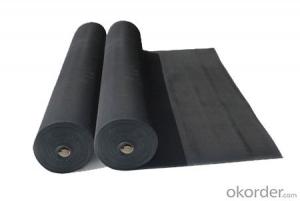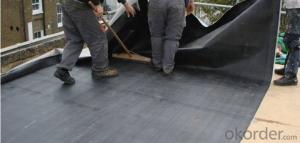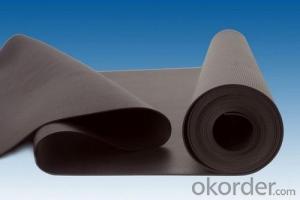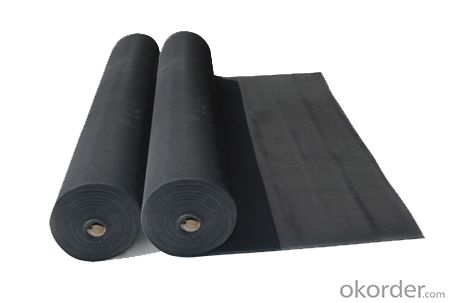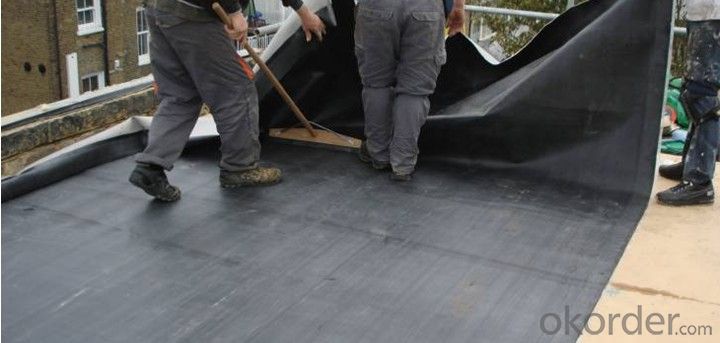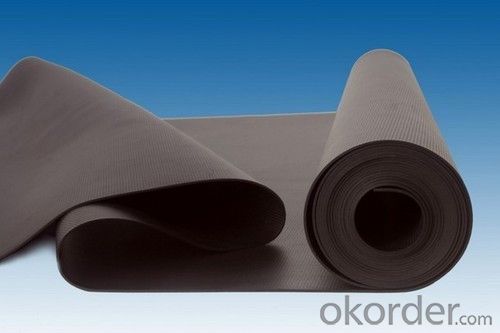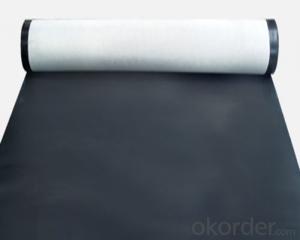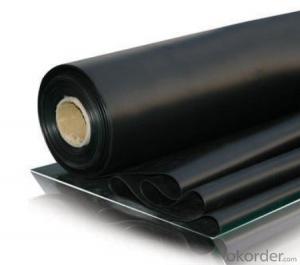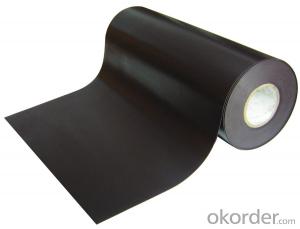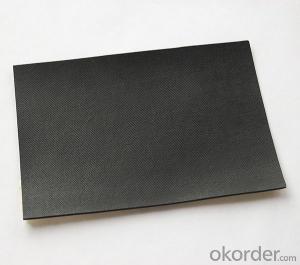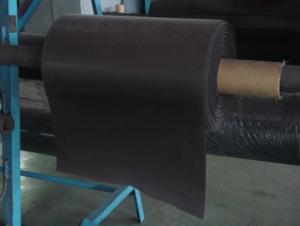Weldable EPDM Waterproofing Membrane for Underlayment
- Loading Port:
- China main port
- Payment Terms:
- TT OR LC
- Min Order Qty:
- 5000 m²
- Supply Capability:
- 100000 m²/month
OKorder Service Pledge
OKorder Financial Service
You Might Also Like
Introduction for EPDM Waterproofing Membrane:
Tensile Strength N/CM | Normal temperature: 60 ; 60°C: 30 |
Breaking Elongation % | Normal temperature: 400 ; -20°C: 10 |
Tear Resistance N | 20 |
Impermeability, 30 min no leakage | 0.3Mpa |
Low Temperature Bending °C | -20 |
Heating Shrinking mm | Extension: 2 Shrink: 4 |
Heat Resistance (80°C×168h) | Tensile Strength % : 80 ; Keeping rate of adhesive breaking:70 |
Alkali resistance (10% ca (oh)2 solution,normal temperature ×168h)) | Tensile Strength % : 80 ; Keeping rate of adhesive breaking:80 |
Synthetic aging | Tensile Strength % : 80 ; Keeping rate of adhesive breaking:80 |
Characteristic of EPDM Waterproofing Membrane:
1. the excellent anti-aging, in the long term light, humidity, cold use of the natural
environment, small changes in physical properties, used in the temperature:
From -50 degree Celsius to +80degree Celsious.
2.with outstanding ozone resistance, resistance to ultraviolet and atmospheric corrosion
of many chemical corrosive substances.
3. high tensile strength, high elongation, high flexibility, capable of sustaining
a puncture of hard material, good anti-crack, high adaptability of the grass roots'
contraction and the crack and deformation, and give full play to extend the
performance, playing the role of waterproofing.
4.long lifetime, high durability can achieve more than 25 years.
5.the cold construction operation, no environment pollution and simple operation.
Usesage of EPDM Waterproofing Membrane:
Widely used in roofs, basement, toilet ,swimming pool, and all kinds of industry and civil building waterproofing, reservoir, bridge, underground, tunnel and dam waterproofing ,especially to the keystone waterproofing projects which is durability, high corrosion resistance and easy deformation
FAQ of Waterproofing Membrane
a.Can we get some samples before place order?
Answer: We can send the free samples to you by freight collect.
b.How many years can your PVC membrane guarantee?
Answer: We will guarantee the quality for 5 years at least.
c.Which countries you ever export the product?
Answer: We export the PVC membrane to South Africa, Middle east and even European countries.
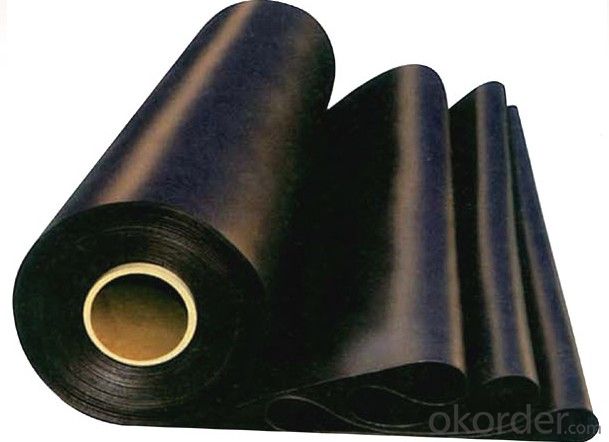
- Q: Can a waterproofing membrane be used in conjunction with fire protection systems?
- Yes, a waterproofing membrane can be used in conjunction with fire protection systems. While the primary function of a waterproofing membrane is to prevent water penetration, it can also act as a barrier to protect against fire. Some waterproofing membranes have fire-resistant properties, allowing them to withstand high temperatures and prevent the spread of fire. However, it is essential to ensure that the specific waterproofing membrane chosen is compatible and approved for use with the fire protection system in question.
- Q: Can a waterproofing membrane be used on plastic surfaces?
- Yes, a waterproofing membrane can be used on plastic surfaces.
- Q: Is a waterproofing membrane resistant to hydrostatic pressure?
- A waterproofing membrane possesses resistance to hydrostatic pressure, preventing water from infiltrating the foundation or structure. Its design forms a barrier against water and is engineered to endure and withstand the pressure exerted by water from soil or external sources. This resistance is achieved by utilizing durable and impermeable materials, such as rubberized asphalt or polyethylene, which can withstand the force exerted by water. Additionally, the membrane is installed in a manner that creates a continuous and seamless layer, further enhancing its ability to resist hydrostatic pressure. In summary, a properly installed waterproofing membrane can effectively safeguard a structure from water intrusion, even when faced with significant hydrostatic pressure.
- Q: Can a waterproofing membrane be used in commercial construction?
- Certainly, a waterproofing membrane is a viable option for utilization in commercial construction. In actuality, it serves as an essential element throughout the construction process. Its purpose is to establish a barrier against moisture, effectively preventing water infiltration and safeguarding the structure from potential water-related harm. This element proves particularly crucial in commercial edifices, where water poses a significant threat to the structural integrity. It can lead to severe problems, including mold proliferation, material deterioration, and even compromise the foundation's stability. Waterproofing membranes find widespread application in various areas of commercial construction, encompassing basements, roofs, foundations, and even external walls. They come in diverse forms, such as sheets, liquid coatings, or spray-applied membranes, allowing for flexibility and adaptability in different construction scenarios. All in all, incorporating a waterproofing membrane in commercial construction endeavors is a prudent investment, ensuring the long-lasting endurance and efficiency of the building.
- Q: Can a waterproofing membrane be used for potable water tanks?
- No, a waterproofing membrane should not be used for potable water tanks. While a waterproofing membrane is designed to prevent water penetration and protect surfaces from moisture damage, it is not suitable for ensuring the safety and purity of potable water. Potable water tanks require materials that are specifically designed and approved for water storage, such as food-grade coatings or liners. These materials are formulated to prevent any leaching or contamination of the water, ensuring its safety for consumption. Therefore, it is important to use the appropriate materials and follow industry standards and regulations when constructing potable water tanks.
- Q: Are there different waterproofing membrane options for above-ground and below-ground applications?
- There is a variety of waterproofing membrane options available for above-ground and below-ground applications. When it comes to above-ground applications, structures like roofs, balconies, or walls require waterproofing. In these cases, commonly used membrane options include liquid-applied membranes, sheet membranes, and polyurethane membranes. These membranes are designed to withstand weather elements, such as UV rays, temperature changes, and foot traffic. On the other hand, below-ground applications involve waterproofing structures like basements, foundations, or tunnels. Below-ground waterproofing membranes are specifically designed to withstand hydrostatic pressure from the surrounding soil and groundwater. These membranes are typically thicker and more durable compared to above-ground membranes. Bituminous membranes, bentonite clay membranes, and composite membranes are commonly used options for below-ground waterproofing. Selecting the appropriate waterproofing membrane for each specific application is crucial due to varying requirements and challenges. Seeking advice from a waterproofing professional or engineer can assist in determining the most suitable membrane option for both above-ground and below-ground applications.
- Q: Can a waterproofing membrane be used for water tanks and reservoirs?
- Yes, a waterproofing membrane can be used for water tanks and reservoirs. These membranes are designed to provide a protective barrier against water penetration, making them suitable for preventing leakage and ensuring the integrity of the tank or reservoir.
- Q: Are waterproofing membranes resistant to acid exposure?
- Yes, waterproofing membranes are generally resistant to acid exposure. They are designed to provide a barrier against water and other corrosive substances, including acids. However, the level of resistance may vary depending on the specific type and quality of the membrane used.
- Q: Can waterproofing membranes be used on concrete stairs?
- Yes, waterproofing membranes can be used on concrete stairs. Waterproofing membranes are designed to create a protective barrier against water and moisture, preventing them from seeping into the concrete and causing damage. Applying a waterproofing membrane to concrete stairs can help to prolong their lifespan, prevent deterioration, and reduce the need for costly repairs in the future. It is important to choose a waterproofing membrane that is specifically designed for use on concrete and follow the manufacturer's instructions for proper application.
- Q: Can a waterproofing membrane be used for planter boxes?
- Yes, a waterproofing membrane can be used for planter boxes to prevent water leakage and protect the surrounding surfaces from moisture damage.
Send your message to us
Weldable EPDM Waterproofing Membrane for Underlayment
- Loading Port:
- China main port
- Payment Terms:
- TT OR LC
- Min Order Qty:
- 5000 m²
- Supply Capability:
- 100000 m²/month
OKorder Service Pledge
OKorder Financial Service
Similar products
Hot products
Hot Searches
Related keywords
